Kane Caves
Microbial Diversity in the Subsurface
The Kane Caves Project
Investigators
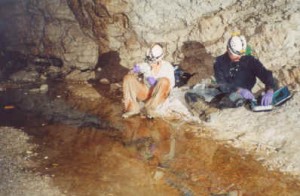 OverviewAn important subsurface microbial community is one based on chemolithoautotrophic oxidation of reduced sulfur compounds, such as hydrogen sulfide or elemental sulfur. Consequently, the main metabolic waste product resulting from this microbial activity is sulfuric acid, and this acid attacks the geologic matrix supporting the microorganisms. In cave and karst settings, this process can be part of sulfuric acid speleogenesis, a mechanism in which limestone dissolves due to sulfuric acid instead of carbonic acid. One of our current research objectives is understanding the role, if any, microbes play in this speleogenesis process.Examining microbial populations in sulfidic habitats, such as hot springs, can be difficult to do. In contrast, caves are direct access points into the subsurface, where microorganisms can be characterized and in situ experimentation can occur. This project examines the geomicrobiology and biogeochemistry of a cave system that has sulfide-rich springs and active microbial communities.This project is currently funded by the NSF/NASA Life in Extreme Environments (LExEn) program, and research in the caves is done in accordance with the Wyoming Bureau of Land Management (Cody office).
OverviewAn important subsurface microbial community is one based on chemolithoautotrophic oxidation of reduced sulfur compounds, such as hydrogen sulfide or elemental sulfur. Consequently, the main metabolic waste product resulting from this microbial activity is sulfuric acid, and this acid attacks the geologic matrix supporting the microorganisms. In cave and karst settings, this process can be part of sulfuric acid speleogenesis, a mechanism in which limestone dissolves due to sulfuric acid instead of carbonic acid. One of our current research objectives is understanding the role, if any, microbes play in this speleogenesis process.Examining microbial populations in sulfidic habitats, such as hot springs, can be difficult to do. In contrast, caves are direct access points into the subsurface, where microorganisms can be characterized and in situ experimentation can occur. This project examines the geomicrobiology and biogeochemistry of a cave system that has sulfide-rich springs and active microbial communities.This project is currently funded by the NSF/NASA Life in Extreme Environments (LExEn) program, and research in the caves is done in accordance with the Wyoming Bureau of Land Management (Cody office).
|
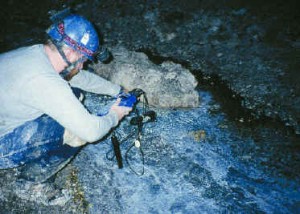 Taking environmental measurements in cave stream with mats. |
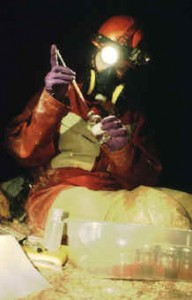 Conducting serial dilutions in the cave for Most Probable Number estimate of microbial diversity. |
Field Site – Geology & Regional Setting
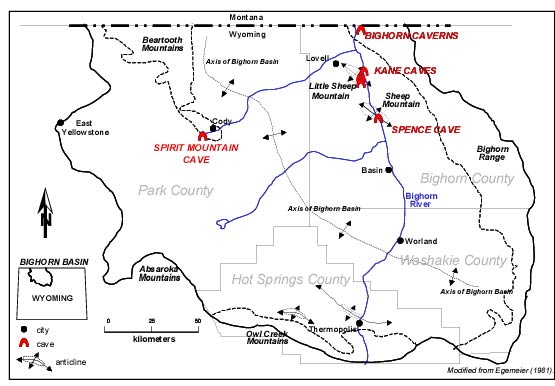
There are several hypotheses regarding the origin(s) of hydrogen sulfide in the Bighorn Basin. One suggests that the hydrogen sulfide is from deep-seated volcanism, similar to Yellowstone. However, it is not known whether the Yellowstone hotspot migration has extended far into the Bighorn Basin. Another hypothesis for the origin of hydrogen sulfide is from oilfield brine solution migration, resulting in a similar cave formation mechanism to those caves in the Guadalupe Mountains, New Mexico and Texas (Hill 1996). The sulfide is most likely generated by sulfate-reducing bacteria in the deep basinal waters. Based on previous work, the areas with the highest sulfide concentrations are centered in small anticlines, such as Little Sheep Mountain and the anticlines near Thermopolis. Presumably, sulfide can rise up at these structural features, where it can mix with meteoric waters and become oxidized.
The Kane Caves are located in the Bighorn Basin near Lovell, Wyoming, approximately 130 km east of Yellowstone National Park and 120 km north of Thermopolis, both areas known for geothermal activity.
The Bighorn Basin contains extensive oil fields and thermal and non-thermal springs that discharge along the flanks of the basin. Anomalous thermal gradients of groundwater temperatures have been recorded throughout the region, as well. The Bighorn Basin is also known for karst development within the Madison Limestone. While most caves have had epigenic development, there are several caves that formed from a hypogenic speleogenesis, including the caves in this study. Across the Bighorn Basin near Cody, and near Jackson Hole, there are additional caves associated with possible sulfuric acid formation.
Geologic Map of Area
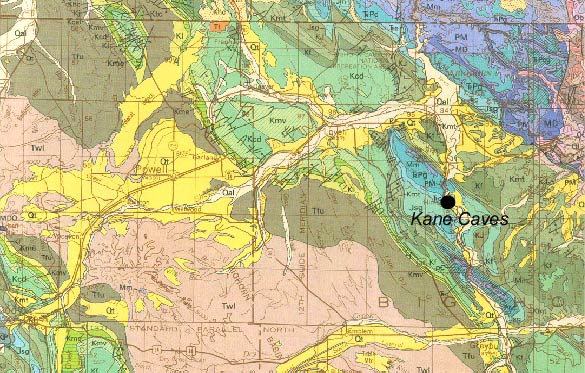
Location map of Kane Caves in the Bighorn Basin. Map modified from Egemeier (1981). The Kane Caves System consist of several caves, including Lower Kane, Upper Kane, Hellspont, and Salamander Caves. All of the caves of the map are managed by the Bureau of Land Management, and permission needs acquired to explore any of them.
October 2002 Smithsonian Magazine “Subterranean Surprises,” by Evan Hadingham with photos by Kevin Downey
“Mysterious Life of Caves” – PBS-NOVA, originally aired October 1, 2002
Out-takes from the PBS-NOVA filming experience, and Shots of the NOVA film crew for “Mysterious Life of Caves”

